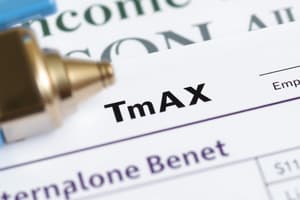Podcast
Questions and Answers
Explain how the principle of horizontal equity applies to a property tax system, and provide a potential challenge in achieving it?
Explain how the principle of horizontal equity applies to a property tax system, and provide a potential challenge in achieving it?
Horizontal equity in property tax means properties of similar value should be taxed the same. A challenge is accurately assessing the market value of all properties to ensure fair and equal taxation.
Describe the difference between a progressive tax system and a regressive tax system, and give an example of a common tax that often acts as a regressive tax.?
Describe the difference between a progressive tax system and a regressive tax system, and give an example of a common tax that often acts as a regressive tax.?
In a progressive system, higher earners pay a larger percentage of their income in taxes, while in a regressive system, lower earners pay a larger percentage. Sales taxes on essential goods can be regressive.
How might elasticity of supply and demand affect who bears the larger burden of an excise tax? Explain.
How might elasticity of supply and demand affect who bears the larger burden of an excise tax? Explain.
If demand is more inelastic than supply, consumers bear a larger burden because they are less responsive to price changes. If supply is more inelastic, producers bear a larger burden as they cannot easily adjust production.
Explain one way a government might try to combat tax avoidance, and contrast this with the illegal practice of tax evasion.
Explain one way a government might try to combat tax avoidance, and contrast this with the illegal practice of tax evasion.
Briefly describe the core idea behind supply-side economics regarding taxation, and mention a concept associated with it.
Briefly describe the core idea behind supply-side economics regarding taxation, and mention a concept associated with it.
Give an example of how behavioral economics might explain why people react differently to a tax versus an equivalent price change that reduces their disposable income by the same amount.
Give an example of how behavioral economics might explain why people react differently to a tax versus an equivalent price change that reduces their disposable income by the same amount.
What is a potential consequence of high corporate tax rates on multinational companies, and why?
What is a potential consequence of high corporate tax rates on multinational companies, and why?
Explain the purpose of tax treaties between countries in the context of international taxation?
Explain the purpose of tax treaties between countries in the context of international taxation?
Describe the term tax incidence and what primary factor determines it?
Describe the term tax incidence and what primary factor determines it?
Explain the difference between tax avoidance and tax evasion?
Explain the difference between tax avoidance and tax evasion?
If a new tax is imposed on a product, how does the elasticity of supply and demand determine whether the consumer or the producer bears a greater burden of the tax?
If a new tax is imposed on a product, how does the elasticity of supply and demand determine whether the consumer or the producer bears a greater burden of the tax?
Define transfer pricing in the context of international taxation and why it's a concern for tax authorities?
Define transfer pricing in the context of international taxation and why it's a concern for tax authorities?
Explain why simplicity is considered an important principle of taxation, and give a specific example of how a complex tax code creates challenges for taxpayers?
Explain why simplicity is considered an important principle of taxation, and give a specific example of how a complex tax code creates challenges for taxpayers?
How might a government use excise taxes to influence consumer behavior, and give a specific example?
How might a government use excise taxes to influence consumer behavior, and give a specific example?
What is the primary difference between estate tax and gift tax, in terms of when they are applied?
What is the primary difference between estate tax and gift tax, in terms of when they are applied?
Explain how the concept of vertical equity in taxation relates to the idea of 'ability to pay'.
Explain how the concept of vertical equity in taxation relates to the idea of 'ability to pay'.
Describe the potential trade-off a government faces when considering a tax reform aimed at simplifying the tax code?
Describe the potential trade-off a government faces when considering a tax reform aimed at simplifying the tax code?
Explain how a payroll tax typically works and what types of programs it is commonly used to fund.
Explain how a payroll tax typically works and what types of programs it is commonly used to fund.
How could implementing a Value Added Tax (VAT) impact businesses differently compared to a traditional sales tax?
How could implementing a Value Added Tax (VAT) impact businesses differently compared to a traditional sales tax?
Explain the Laffer Curve and why it is significant in discussions about taxation.
Explain the Laffer Curve and why it is significant in discussions about taxation.
Flashcards
Taxation
Taxation
A system where a government levies charges on its citizens and entities to finance public services.
Horizontal equity
Horizontal equity
The principle that those in similar situations should pay the same amount of taxes.
Vertical equity
Vertical equity
The principle that wealthier individuals should pay a higher proportion of their income in taxes.
Tax Certainty
Tax Certainty
Signup and view all the flashcards
Tax Efficiency
Tax Efficiency
Signup and view all the flashcards
Tax Simplicity
Tax Simplicity
Signup and view all the flashcards
Tax Flexibility
Tax Flexibility
Signup and view all the flashcards
Income Tax Definition
Income Tax Definition
Signup and view all the flashcards
Progressive Tax System
Progressive Tax System
Signup and view all the flashcards
Sales Tax
Sales Tax
Signup and view all the flashcards
Property Tax
Property Tax
Signup and view all the flashcards
Excise Tax
Excise Tax
Signup and view all the flashcards
Payroll Tax
Payroll Tax
Signup and view all the flashcards
Value Added Tax (VAT)
Value Added Tax (VAT)
Signup and view all the flashcards
Estate Tax
Estate Tax
Signup and view all the flashcards
Gift Tax
Gift Tax
Signup and view all the flashcards
Tax Incidence
Tax Incidence
Signup and view all the flashcards
Tax Avoidance
Tax Avoidance
Signup and view all the flashcards
Tax Evasion
Tax Evasion
Signup and view all the flashcards
Tax Reform
Tax Reform
Signup and view all the flashcards
Study Notes
- Taxation is a system by which a government levies charges on its citizens and entities to finance public services
Principles of Taxation
- Equity: Tax burden should be distributed fairly
- Horizontal equity suggests people in the same situation pay the same taxes
- Vertical equity suggests wealthier people pay more
- Certainty: Tax rules must be clear and easy to understand
- Efficiency: Tax system should minimize economic distortions and administrative costs
- Simplicity: Tax laws should be easy for taxpayers to comply with
- Flexibility: Tax system should be adaptable to economic changes
Types of Taxes
- Income Tax: Levied on individuals' and companies' income
- Can be progressive (higher income, higher rate), regressive (higher income, lower rate), or proportional (same rate for all income levels)
- Sales Tax: Levied on the sale of goods and services
- Usually a percentage of the sale price
- Property Tax: Levied on real estate and other property
- Often used to fund local services like schools and infrastructure
- Excise Tax: Levied on specific goods, such as alcohol, tobacco, and gasoline
- Often used to discourage consumption of these goods
- Payroll Tax: Levied on wages and salaries to fund social insurance programs
- Examples include Social Security and Medicare taxes in the U.S.
- Value Added Tax (VAT): Levied on the value added at each stage of production
- Common in many countries outside the U.S.
- Estate Tax: Levied on the transfer of property after death
- Gift Tax: Levied on the transfer of property during a person's life
Tax Systems
- Progressive Tax System: Higher earners pay a larger percentage of their income in taxes than lower earners
- Regressive Tax System: Lower earners pay a larger percentage of their income in taxes than higher earners
- Proportional Tax System: All earners pay the same percentage of their income in taxes
Tax Incidence
- Tax incidence refers to who ultimately bears the burden of a tax
- It depends on the elasticity of supply and demand
- When demand is more inelastic than supply, consumers bear a larger burden of the tax
- When supply is more inelastic than demand, producers bear a larger burden of the tax
Tax Revenue
- Tax revenue is the income that a government receives from taxation
- It is used to fund public services such as healthcare, education, and infrastructure
- Tax revenue can be affected by economic conditions, such as recessions or booms
- Governments may adjust tax rates to increase or decrease tax revenue
Tax Avoidance and Evasion
- Tax avoidance is the legal use of the tax system to reduce one's tax liability
- Strategies include claiming deductions, credits, and exemptions
- Tax evasion is the illegal act of failing to pay taxes
- Examples include underreporting income or overstating deductions
- Governments have measures to combat both tax avoidance and evasion
Tax Reform
- Tax reform refers to changes made to the tax system
- Reasons for tax reform include simplifying the tax code, increasing revenue, or promoting economic growth
- Tax reform can be controversial, as different groups may benefit or be harmed by the changes
Supply-Side Economics
- Supply-side economics emphasizes the role of taxation in influencing aggregate supply
- Lowering marginal tax rates can incentivize people to work, save, and invest more
- Increased supply can lead to economic growth
- Supply-side economics is often associated with the Laffer curve, which suggests that there is an optimal tax rate that maximizes tax revenue
Behavioral Economics
- Behavioral economics studies how psychological factors affect decision-making, including tax compliance
- Framing effects can influence how people perceive taxes
- Loss aversion can make people more sensitive to taxes than to equivalent gains
- Defaults can affect participation in tax-advantaged savings plans
Corporate Tax
- Corporate tax is a tax on company profits
- It can impact investment and hiring decisions
- High corporate tax rates may encourage companies to relocate to countries with lower rates
- There is debate about the optimal corporate tax rate
International Taxation
- International taxation involves the taxation of cross-border transactions
- Transfer pricing is a key issue in international taxation
- Multinational corporations may shift profits to low-tax jurisdictions
- Tax treaties exist between countries to avoid double taxation
Studying That Suits You
Use AI to generate personalized quizzes and flashcards to suit your learning preferences.




